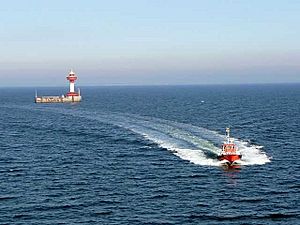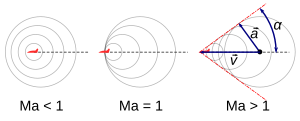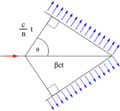Čerenkov radiation facts for kids

Cherenkov radiation, also known as Vavilov–Cherenkov radiation, is a special kind of light. It's made when tiny charged particles, like electrons, zoom through a clear material (like water or glass) faster than light usually travels in that material.
This might sound like it breaks the rules of special relativity, which says nothing can go faster than light. But it doesn't! Light actually slows down when it travels through materials like water. So, a particle can still be slower than light in empty space (a vacuum) but faster than light in water.
This cool effect is named after Pavel Cherenkov, who first saw it in 1934. Later, Igor Tamm and Ilya Frank helped explain how it works. These three scientists even won the Nobel Prize in Physics in 1958 for their work on Cherenkov radiation.
How It Works
You might know that nothing can move faster than the speed of light in empty space. But when light travels through clear stuff like water or glass, it slows down. This means that tiny particles can actually move faster than light does in those materials!
When a charged particle moves faster than light in a material that can be polarized (meaning its tiny parts can be pulled apart by electric forces), it makes the material send out tiny packets of light called photons. When these photons are sent out, the particle loses some of its energy. We can measure these photons because they are just light.
Understanding Cherenkov Radiation
Imagine a power boat zipping across water faster than the waves it creates. It makes a special "bow wave" in front of it. Or think of a jet plane flying faster than the speed of sound. It creates a loud "sonic boom" as it passes.
Cherenkov radiation happens in a similar way, but with light waves instead of sound or water waves.
When a charged particle moves through a material, it excites some of the electrons in that material. When these excited electrons calm down, they let out electromagnetic radiation (which is light). If the particle moves faster than the speed of light in that material, these light waves add up. They create a special glow that we call Cherenkov radiation.
Since nothing can move faster than light in empty space, you won't see Cherenkov light in a vacuum. But if light in water moves at only 75% of its speed in a vacuum, then very energetic particles can move faster than light through water and create this special glow.
Cherenkov light often looks blue. This is because the effect is stronger for higher frequencies of light. Higher frequency light has shorter wavelengths. Blue light has one of the shortest wavelengths of visible light, so Cherenkov light usually appears blue.
Images for kids
See also
 In Spanish: Radiación de Cherenkov para niños
In Spanish: Radiación de Cherenkov para niños










